|
|
|
Sort Order |
|
|
|
Items / Page
|
|
|
|
|
|
|
| Srl | Item |
| 1 |
ID:
055026


|
|
|
| 2 |
ID:
112632
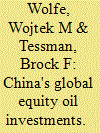

|
|
|
|
|
| Publication |
2012.
|
| Summary/Abstract |
In this article, we construct and analyze an original database of overseas Chinese equity oil investments (EOI) in order to assess the relative importance of economic and geopolitical factors in determining the type of countries that are most likely to receive those investments. We find that China's national oil companies (NOCs) choose to make considerable investments in certain oil rich countries while ignoring others. We develop and examine 'economic opportunity' and 'geopolitical relevance' explanations of Chinese EOI. The economic explanation assumes that Chinese oil companies operate autonomously despite the fact that they are state owned, and that they seek international experience in countries offering less competition but more risk. The geopolitical explanation suggests that Chinese equity oil investments are developed and coordinated by the central government as part of a geopolitical strategy that is designed to bypass the so-called 'Malacca Dilemma' and deepen security ties with oil-rich states through the conduct of oil diplomacy. We argue that Chinese EOI tends to reflect both corporate interests and government priorities, and that it generates more liabilities rather than benefits for China.
|
|
|
|
|
|
|
|
|
|
|
|
|
|
|
|
| 3 |
ID:
108461
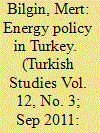

|
|
|
|
|
| Publication |
2011.
|
| Summary/Abstract |
This paper focuses on the shift in Turkey's energy policy and analyzes the development of energy mix, investments plans and pipelines. The paper indicates how energy security, which was originally conceived as an input of development, became a strategic tool for Turkey's regional and foreign relations. It elaborates Turkey's actual energy strategy, which has recently been introduced by the state authorities. The article addresses investment opportunities and restraints with a particular focus on pipeline politics. It ends by identifying Turkey's assumptions about the future. The conclusion points out the consistencies and contradictions between Turkey's energy security and its aspiration to benefit from pipeline politics.
|
|
|
|
|
|
|
|
|
|
|
|
|
|
|
|
| 4 |
ID:
074837
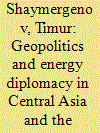

|
|
|
| 5 |
ID:
058494
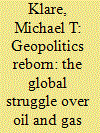

|
|
|
| 6 |
ID:
162891
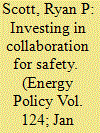

|
|
|
|
|
| Summary/Abstract |
Oil and gas pipeline leaks are the responsibility of a wide range of stakeholders including utilities, the public, construction firms and state safety program personnel. As a result, in the United State, state pipeline safety programs focus heavily on public education, outreach, and stakeholder participation so as to reduce the occurrence of these events. The US Pipeline & Hazardous Materials Safety Administration (PHMSA) directs federal support to state safety efforts through formula and project grant programs for state and local agencies that emphasize different aspects of collaboration. We combine these grant data with nationwide, longitudinal records on pipeline leaks, and use a multilevel Bayesian model to evaluate how different grant emphases relate to subsequent incident rates. State damage prevention grants are not associated with reductions in leaks but are associated with improvements in error recognition. Pipeline incidents are downstream from safety programs and impacts and identifying, minimizing, and correcting leaks requires states to motivate utility actions while also attempting to improve public awareness. This makes assessment of safety outcomes a challenge without better tracking of safety program communications and participation. In conclusion, we suggest improvements to data provision by states that could provide improved evidence for assessing safety improvements.
|
|
|
|
|
|
|
|
|
|
|
|
|
|
|
|
| 7 |
ID:
094212
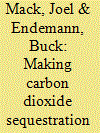

|
|
|
|
|
| Publication |
2010.
|
| Summary/Abstract |
As the United States moves closer to a national climate change policy, it will have to focus on a variety of factors affecting the manner in which the country moves toward a future with a substantially lower carbon footprint. In addition to encouraging renewable energy, smart grid, clean fuels and other technologies, the United States will need to make substantial infrastructure investments in a variety of industries. Among the significant contributors to the current carbon footprint in the United States is the use of coal as a major fuel for the generation of electricity. One of the most important technologies that the United States can employ to reduce its carbon footprint is to sequester the carbon dioxide ("CO2") from coal-fired power plants. This article focuses on the legal and policy issues surrounding a critical piece of the necessary sequestration infrastructure: CO2 pipelines that will carry CO2 from where it is removed from fuel or waste gas streams to where it will be sequestered. Ultimately, this article recommends developing a federally regulated CO2 pipeline program to foster the implementation of carbon sequestration technology.
|
|
|
|
|
|
|
|
|
|
|
|
|
|
|
|
| 8 |
ID:
177170


|
|
|
|
|
| Summary/Abstract |
The exploitation of low-cost shale gas in the Marcellus Formation, the deregulation initiatives in the U.S. and Mexico, and the emergence of natural gas as a bridging fuel to a low-carbon economy has fueled the growth of North American natural gas production, which is projected to keep growing in the mid-term to support the increasing LNG exports. Greater introduction of renewables and deeper electrification suppress both supply and demand for natural gas in the long-term. The long lead times of pipeline operation and field exploitation render the timing of natural gas abatement critical to natural gas infrastructure stakeholders. Full integration of the U.S., Canadian, and Mexican natural gas markets implies that the abatement trajectories of the three countries are tightly linked. This paper studies the development of the integrated North American natural gas markets and infrastructure under different assumptions on resource availability, technological progress, and global crude oil prices. We quantify the impact of each scenario by using the North American Natural Gas Model. Our analysis shows that cross-border U.S.-Mexico trade is more resilient under all three shocks compared to U.S.-Canada trade. Increasing Mexican production could drive the growth of the domestic Mexican market instead of reducing U.S.-Mexico trade.
|
|
|
|
|
|
|
|
|
|
|
|
|
|
|
|
| 9 |
ID:
106325


|
|
|
|
|
| Publication |
2011.
|
| Summary/Abstract |
Northeast Asia consists of China, Japan, the two Koreas, the Russian Far East, and Mongolia. Korea is the country where the interests and influences of the four big global powers-China, Russia, Japan, and the United States-are closely interlocked. The peninsula has functioned as a land bridge between the Asian continental powers (China and Russia) and the oceanic powers (Japan and the United States) for both cultural exchange and military aggression. However, this land bridge has been broken since the end of World War II because the peninsula has been divided into two separate states, North Korea and South Korea.
|
|
|
|
|
|
|
|
|
|
|
|
|
|
|
|
| 10 |
ID:
102377


|
|
|
|
|
| Publication |
London, Zed Books, 2010.
|
| Description |
xiv, 208p.
|
| Standard Number |
9781848134683, hbk
|
|
|
|
|
|
|
|
|
|
|
|
Copies: C:1/I:0,R:0,Q:0
Circulation
| Accession# | Call# | Current Location | Status | Policy | Location |
| 055811 | 387.54480951/FRE 055811 | Main | On Shelf | General | |
|
|
|
|
| 11 |
ID:
055196
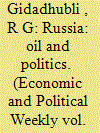

|
|
|
| 12 |
ID:
174950


|
|
|
|
|
| Summary/Abstract |
When Aleksei Kosygin visited Turkey in 1975 for the inaugural firing of a massive Soviet-built steelworks, he laid out an ideologically charged vision of development: “unlike the Americans with their Coca-Cola factories, we contribute to industrialization.”1 The Soviet chairman of the council of ministers picked an unusual audience for his disparagement of the United States. Even though Washington had recently imposed an arms embargo in response to Ankara’s intervention on Cyprus, Turkey was still a NATO member. More to the point, Turkey had been a key recipient of U.S. aid since the beginning of the Cold War.2 The Soviet Union could not truly compete with the Western investments that included a Coca-Cola plant which opened in Istanbul in 1964, but Moscow nevertheless committed extensive resources to industrial sites in Anatolia in the 1960s and 1970s. Given that Turkey was closer to the Transatlantic Alliance than the Non-Aligned Movement, the Soviet challenge to U.S.-led modernization in Turkey is an unusual and thus revealing place to find what looks like Cold War competition to develop the Global South.
|
|
|
|
|
|
|
|
|
|
|
|
|
|
|
|
| 13 |
ID:
072824


|
|
|
| 14 |
ID:
156101


|
|
|
|
|
| Summary/Abstract |
In December 2015, leaders from Central and South Asia took part in the ground-breaking ceremony for the Turkmenistan-Afghanistan-Pakistan-India (TAPI) natural gas pipeline project. Sixteen months later, a confusing information flow continues to obfuscate external assessments of the project’s development: official rhetoric notwithstanding, there is no certainty on the details of project financing, while the pipeline route has yet to be determined. To illuminate this obscure implementation path, this article regards TAPI as a virtual pipeline, an infrastructure project that wields invaluable influence only when it is employed as a foreign policy tool or permeates domestic discourses of progress framed by the elites of the four consortium partners. The constituent elements of TAPI virtuality are discussed here through a dedicated focus on the process of energy policy-making of Turkmenistan – the sole supplier of gas for the pipeline project and the consortium’s key stakeholder.
|
|
|
|
|
|
|
|
|
|
|
|
|
|
|
|
|
|
|
|
|